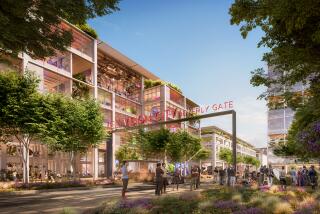Project Is Destined for Change
- Share via
For a decade, the proposed development of Porter Ranch has served as a metaphor for the maturation of the San Fernando Valley as an urban place.
Once the wide-open suburbs, the Valley--like it or not--is now truly urban, with more than 1 million residents and more jobs than Detroit. This transformation has not been easy, of course; crime and congestion are on the rise, and nostalgia about the old suburban days is increasing as well. But there’s no turning back: Officially or unofficially, the Valley is now a city.
As the last large tract of open land in the Valley, Porter Ranch, tucked into the hills of Chatsworth at the northwest corner of the Valley, represents the last chance to build this overgrown suburb right. Once Porter Ranch is gone, there will be no place else to sprawl to. The Valley, like Los Angeles itself, will have no choice but to look inward--to confront its problems by dealing with communities that already exist rather than promising a better life someplace farther out.
In the go-go years of the 1980s, the Los Angeles City Council approved a huge development for 1,300 acres of the Porter Ranch property: more than 3,000 homes and some 6 million square feet of commercial space (the equivalent of six huge downtown skyscrapers), including plans for an upscale, Nordstrom-type regional shopping mall.
Now Porter Ranch’s developers have made some typical ‘90s adjustments to this ‘80s dream. In so doing, they’ve made a few concessions to local homeowners--concessions that suggest how enduring the suburban dream is in the Valley today, especially in the northwestern foothills where you can still pretend to live a quiet, semirural life.
The big change is that the developers have agreed to cut the commercial space from 6 million square feet to 4.7 million square feet at most, and maybe down to as little at 3.5 million square feet. And the retail “mix” is changing as well. Gone is the Nordstrom dream, replaced by a 660,000-square-foot shopping center north of the 118 Freeway that is likely to be anchored by a large discount retailer.
Such changes are not uncommon in the 1990s. Throughout Southern California, developers (and cities) have abandoned dreams of monumental office complexes and regional malls because of changing market conditions. A decade ago it was possible for developers to persuade investors to give them the money to build these large-scale projects. Today the office market is flat, the regional mall is dying--and the easy money lies in building Wal-Marts, Home Depots and other retailing “power centers” where people can do discount shopping in bulk. In this regard, the Porter Ranch project is little different than Calabasas Park Centre in Calabasas or Camarillo Premium Outlets, both sites that were originally approved for office or warehouse space but later revised to emphasize retailing.
*
To win approval of the neighbors, the Porter Ranch developers gave away a pretty typical set of concessions. Several streets will dead-end so they won’t run through adjacent neighborhoods, and the whole issue of whether to permit apartments as part of the project will be reexamined. These two issues--heavy traffic and high-density housing--typically rank as suburbanites’ top two fears, because they are perceived as the biggest threats to the peace and quiet of suburban life.
Yet heavy traffic and high-density housing are unavoidable in a suburb-turned-city like the Valley. When activity becomes dense, increased traffic congestion is inevitable. When land prices get too high, high-density housing usually follows. It may be possible for suburbanites to keep these supposedly undesirable things off their street or even out of their neighborhood, but in a community running out of land, they will have to be confronted sooner or later.
There’s no guarantee, of course, that Porter Ranch will be “built out” according to the revised plan. Real estate markets are volatile, meaning that the kind of project developers can get financed in 1997 may be very different than what they can get financed in 2001 or 2003. Large projects like Porter Ranch typically return to city officials several times over a 10- or 20-year period for alterations that respond to these changing market trends.
As this year’s changes suggest, there’s no telling what a developer may want or need a few years down the road--or what he’s willing to give up to get it. This year, Porter Ranch was willing to give up a little housing and a little efficiency in traffic flow in order to get a retail center (needed by the developer for revenue purposes) up and running quickly. But a few years from now, the very things the developer appears willing to give up this year--high-density housing, for example--may be the only thing he can get financed by real estate investors on Wall Street.
All of which means that the Porter Ranch story is not over yet, and it will evolve in the future in much the same way that the Valley itself is evolving. Porter Ranch will grow bigger; it will change in unexpected ways; and as time goes on, it will probably have to redefine itself as more undeniably urban in nature. This may not be a happy thought for the Valley’s suburbanites--but it’s undoubtedly the way the Valley is headed.
More to Read
Inside the business of entertainment
The Wide Shot brings you news, analysis and insights on everything from streaming wars to production — and what it all means for the future.
You may occasionally receive promotional content from the Los Angeles Times.










